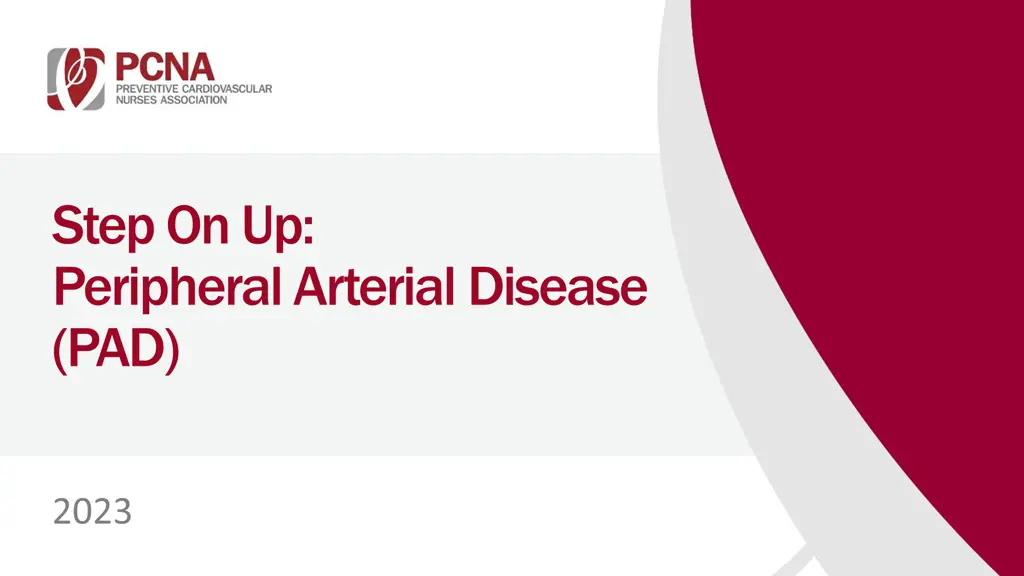Step On Up: Peripheral Arterial Disease (PAD)
Peripheral Arterial Disease (PAD), a condition caused by reduced blood flow in the legs or arms. Understand the symptoms, signs, importance of early detection, and who is at risk. Find out about the tests for PAD.
- Peripheral Arterial Disease
- reduced blood flow
- symptoms
- signs
- importance
- early detection
- risk factors
Download Presentation

Please find below an Image/Link to download the presentation.
The content on the website is provided AS IS for your information and personal use only. It may not be sold, licensed, or shared on other websites without obtaining consent from the author. Download presentation by click this link. If you encounter any issues during the download, it is possible that the publisher has removed the file from their server.
E N D
Presentation Transcript
Step On Up: Peripheral Arterial Disease (PAD) 2023
Acknowledgements Thank you to Janssen Pharmaceuticals, Inc. for support of this program.
What is Peripheral Arterial Disease? Peripheral arterial disease, or PAD, is a health condition caused by reduced or sluggish blood flow in the arteries of your legs or arms. Arteries are tubes or vessels under the skin and muscles that carry oxygen to your body.
What does PAD feel like? You might have PAD and not know it. The symptoms can be similar to normal signs of aging. Cramps, pain or tired feeling in your leg or hip muscles when you walk, climb stairs or exercise. Pain might go away when you rest.
What are other signs of PAD? A sore on your foot or leg that won t heal or is slow to heal A leg or foot that looks reddish- blue when you are sitting For men, they may experience erectile dysfunction, especially those with diabetes
What are other signs of PAD? Leg or foot feels cool to the touch Dry and scaly skin on the leg Poor toenail growth Hair loss on feet or toes
Why is it important to know about PAD? PAD is associated with higher risk of heart attack or stroke. PAD can get worse over time. Complete blockage of blood flow can cause permanent damage to the area below the blockage on your body. If not treated, PAD can cause infection,(gangrene) or lead to amputation.
Who is at risk for having PAD? High blood sugar, diabetes Smoking - current or past High blood pressure High cholesterol Age over 70 Overweight or obese Physically inactive
What are the tests for PAD? Tell your nurse or doctor if you any symptoms or tell them if you have any risk factors even if you do not have symptoms They can quickly evaluate you using an Ankle-Brachial Index, also known as an ABI Compares blood pressure in feet and arms Painless Inexpensive
What do my ABI results mean? ABI = Highest BP in Foot Highest BP in Arm Normal ABI 1.0 1.4 ABI less than 0.9 More testing may be needed. See your health care provider.
What are the tests for PAD? Doppler Ultrasound Handheld device pressed against the skin of your leg or foot Uses soundwaves and sends pictures of your arteries to a screen to show how well your blood is flowing
What are the tests for PAD? Treadmill Test You walk on a treadmill at different speeds to show how exercise affects your leg pain and how severe your symptoms are
What are the tests for PAD? Magnetic Resonance Angiogram (MRA) You lie flat inside a large, tunnel-like tube. Pictures are taken to show where your arteries are, and how much they are blocked.
What are the tests for PAD? Arteriogram A special medicine called contrast is given to you through an IV. You lie flat and a machine with a camera takes pictures using X-rays to find the exact location of a blockage in your arteries.
What are the treatments for PAD? Regular walking and activity At home, or supervised exercise sometimes called Cardiac Rehab Medications Surgery and other procedures
What are the treatments for PAD? If you smoke, stop smoking cessation resources are available Join a Cardiac Rehabilitation exercise program Follow a heart- healthy eating plan Lose weight
Where can I get information on PAD? Preventive Cardiovascular Nurses Association PCNA.net/PAD American Heart Association heart.org/en/health-topics/peripheral-artery-disease NHLBI nhlbi.nih.gov/health/peripheral-artery-disease Vascular Nurses vascularcures.org/patients/patient-resources





























